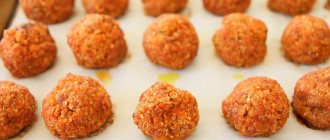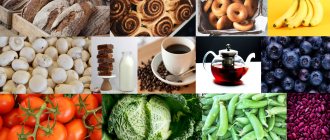Important Foods for Four Year Olds
A balanced diet always has a positive effect on the health of children.
This is an integral part of the proper development of the growing body. When thinking over the weekly menu for a preschool child, special attention should be paid to the following products
Meat and meat products
During the period of intensive growth, meat becomes the main supplier of energy and protein for the child's body. Unlike the diet of a child aged 1-3 years, meat can now be safely included in the diet. Kids will like the prepared meat dishes - these can be meatballs, cutlets or baked meat in the oven, which children love. Little gourmets will also enjoy meat stewed in the form of a stew or roast with vegetables, as well as gravy for side dishes.
Sausages and sausages are not always suitable for replenishing protein reserves. There is not enough real meat in the store assortment, and such products are considered harmful to children due to chemical additives of the E series and high salt content.
Fish and dishes made from it
This product contains calcium, phosphorus, iodine and other beneficial minerals. They are extremely necessary for the development of the skeletal system and the proper formation of the skeleton. Fish is a source of vitamins that strengthen the child’s immunity.
The iodine contained in sea fish supports the baby’s nervous system and promotes the development of intelligence.
Cottage cheese, sour cream, milk, kefir
Dairy products contain essential calcium, which is involved in the strengthening and formation of healthy and strong bones and teeth. During the period of changing baby teeth to permanent ones, fermented milk products are simply necessary in the child’s menu.
The beneficial properties of lactic bacteria will support healthy microflora and provide strong immunity.
Chicken and quail eggs
This product is also necessary in the menu of children over 4 years of age due to the beneficial properties of vitamin D contained in the yolk. Egg yolk also contains substances necessary for the proper functioning of the nervous and immune systems. Egg white is actively involved in building muscle tissue.
In addition, scientists have found that eggs are easily digested in the child’s body. This is a product that energizes and helps cope with drowsiness.
Oils: butter and vegetable
When preparing lean vegetable dishes, it is worth remembering the need to add a tablespoon of oil to the finished dish.
Vegetable oil (sunflower, olive or corn) is rich in omega fatty acids, which is very important for the maturing body
Like cottage cheese, butter containing calcium is also important
Just pay attention to the fat content of butter. 82% of cream is considered natural butter
Everything below contains additional plant impurities.
Fresh fruits and vegetables
For proper bowel function, fiber is needed in fresh fruits and vegetables. However, fruits should be given before afternoon tea for complete digestion and absorption.
The norm of vegetables and fruits per day for a child is 250 g.
Nutrition to strengthen the child’s immunity in kindergarten
The transition of a child to being raised in a group of preschool institutions is always accompanied by psychological difficulties, while appetite may decrease, insomnia and neurotic reactions may appear, and the body’s overall resistance to infectious diseases decreases. Proper nutrition will help cope with these problems. It is necessary to bring home food closer to what is received in kindergarten, especially if there are dishes that the child has never eaten before.
To prevent seasonal colds, pay attention to the content of vitamins in food, using fortified fresh foods and drinking vitamin preparations in courses. The child must eat meat, since protein is the structural material of the immune system
You can drink decoctions of rosehip, mint, linden, chamomile, viburnum, cranberry juice in courses of 2-3 weeks; teas and drinks with ginger with the addition of lemon and a spoon of honey are especially useful.
Get your child used to onions and garlic: they contain phytoncides - substances with powerful antiviral and antimicrobial properties. And don’t forget to eat foods rich in iron.
Diet examples
If the children's menu is compiled correctly, the child gets sick less often, is less susceptible to infection with viruses, feels better and is ready to learn and play. Your daily diet should include meat, dairy products, grains, fiber and oil. Bread must be present in the daily diet of children. Children under 3 years of age are offered black or gray bread, while older children are given a choice of white or black. Several times a week, children are given cottage cheese, fish, eggs and cheese.
In addition, the children's menu must include juices, fruit compotes, jelly, and jelly. For an afternoon snack or second breakfast, children are offered fresh fruit as a snack. Seasonal berries are added to the summer menu.
Here is an example of the correct menu for a week for a kindergarten.
Monday:
- breakfast: semolina porridge, chicory coffee drink with milk, sandwich with butter and cheese;
- second breakfast: “snowball” 200 ml, shortbread;
- lunch: rassolnik soup, pasta, beef goulash with gravy, bread, compote;
- afternoon snack: fruit juice and half an apple (60 g);
- dinner: boiled white sea fish fillet, Polish vegetables, tea with sugar, cookies.
Tuesday:
- breakfast: barley porridge with milk, tea, cookies;
- second breakfast: omelet, apple juice;
- lunch: borscht with beans and sour cream, potato casserole, dried apricot compote;
- afternoon snack: kefir 200 ml, curd mass;
- dinner: chicken in sour cream sauce, vegetable stew, berry juice.
Wednesday:
- breakfast: oatmeal with milk, bun, sweet tea;
- second breakfast: pancakes with sweet filling, vitamin juice;
- lunch: cream soup with croutons, beef meatballs with gravy, noodles with butter, fruit compote;
- afternoon snack: yogurt, seasonal fruit;
- dinner: dumplings with potatoes, tea.
Thursday:
- breakfast: milk soup with noodles, bun, cocoa;
- second breakfast: pancakes, condensed milk, tea;
- lunch: soup with lazanka, white sea fish fillet, rice, fresh apple compote;
- afternoon snack: “snowball” 200 ml, butter pastries;
- dinner: peppers stuffed with meat and rice, tea with sugar, bagels.
Friday:
- breakfast: buckwheat milk porridge, gingerbread, cocoa;
- second breakfast: fruit jelly;
- lunch: kharcho soup, mashed potatoes, fish, berry juice;
- afternoon snack: sea buckthorn jelly, bun with raisins;
- dinner: macaroni and cheese, tomato and cucumber salad, tea with lemon.
Any menu for the week is approved by the head of the kindergarten. Each parent can familiarize themselves with such a menu independently when entering the group. Private kindergartens tend to offer a more varied and interesting menu for children, since such institutions have an unlimited budget and can choose not only those products that are supplied to the kindergarten by an approved supplier.
Principles and rules of diet for children
When starting to create a menu for a child, you need to adhere to a number of rules. They will make the diet as effective as possible.
- A child needs vitamins, minerals and other useful substances, which he can only get from food. It is important that the menu is not devoid of fats, proteins and carbohydrates. Deficiency of nutrients is unacceptable.
- A child should not experience hunger that is unacceptable to him.
- A child should not be allowed to be completely deprived of sweets, despite the fact that he is on a diet. However, they should be useful.
- A children's diet cannot be strict. This is contrary to all medical principles. There are no indications for a strict diet for children.
The principles on which any children's diet is built:
- A balanced menu, with an emphasis on protein products. They should be at least 50% in the daily diet.
- Compliance with the caloric content of dishes according to the age characteristics of the body.
- Lack of foods on the menu that contribute to weight gain.
In addition to all of the above principles and rules for creating a children's diet, it is also necessary to take into account the following recommendations:
- You need to eat 5-6 times a day.
- During the day you need to distribute products correctly:
- At breakfast, the child should eat 25% of the daily diet.
- During lunch – 10%.
- Lunch accounts for 40%.
- For afternoon tea – 5%.
- At dinner he eats 20% of the entire menu offered.
- Before lunch, the menu should be dominated by protein products, and in the evening - vegetables and cereals.
- You can’t eat a lot without following a regimen.
- Children should eat foods that are gently cooked. You can steam, bake, stew and boil.
If there are no medical indications, then a child under 5 years of age cannot be allowed to follow a diet. Limiting the food supply can lead to a failure in the absorption of nutrients, disrupt metabolism, and therefore provoke excess body weight gain. A young child should eat properly and should not be offered unhealthy foods or sweet carbonated water.
Main products in the menu of a one-year-old child
Meat should be present in a child’s diet every day, up to one hundred grams.
It could be:
- Beef;
- Pork;
- Bird;
- Rabbit.
Consumption of by-products is allowed; liver is considered especially useful due to its high iron content. You can cook the heart or tongue, but it is better in a stuffed form, such as meatballs or meatballs. Animal fats enter the body along with meat, but vegetable fats are also necessary.
You can include fish in your child’s diet twice a week, and on this day you don’t have to give meat. The variety should be selected carefully so that it is lean and boneless. This could be sea bass, cod or pike perch.
Dairy products continue to form the basis of the child’s diet. Daily consumption of up to 650 ml is required. At this age, you can consume fermented milk products, which must be fresh and reliably prepared.
The daily menu of a one-year-old child for each day should not exceed 1200 - 1250 ml in volume.
Cottage cheese can be diluted with low-fat sour cream and given to the child up to 40 g daily. One meal should consist of porridge. Corn and buckwheat are considered the most valuable. You can offer your child oatmeal, rice, millet and wheat porridge.
A child can consume up to 100 g of white bread per day. Occasionally, it is possible to include in the diet pasta, which contains fast carbohydrates and can be consumed as a side dish or as part of soups. It is necessary to gradually include butter in porridge or puree.
Due to the allergenicity, eggs are introduced into the child’s diet carefully, and only chicken or quail eggs. Can be served boiled or as an omelette
It is advisable to add oil to the dish at the end of cooking, so as not to subject it to prolonged processing and it does not produce a carcinogen.
For sweets, a one-year-old child should receive marmalade or jam. Honey is also useful if it does not cause allergies. Dried fruits and cookies are allowed.
Rules for creating a menu
A proper children's diet is based on the general principles of proper nutrition. The diet is based exclusively on natural products. All foods with hot spices, large amounts of salt, glutamate, and dyes are excluded.
Basic rules when creating a menu:
- fractionality. A brutal appetite should not be allowed. A healthy children's diet consists of at least five meals with an interval of 2.5 hours;
- sufficient amount of protein. There is 1 g per kilogram of weight, that is, for a child weighing 35 kg, 35 g of proteins are required. The main sources are beef, chicken, fish, eggs and dairy products;
- protein dinner. There is no need to supplement the cutlet with porridge or potatoes, but you can add fresh or stewed vegetables to it;
- full breakfast. It should contain complex carbohydrates and a small portion of protein. Also in the first half of the day you can eat something sweet, some kind of pastry. It is better not to mix it with the first breakfast, leave it for a snack;
- a lot of fiber. It prevents hunger, promotes satiety and accelerates weight loss, found in vegetables, beans, and cereals;
- minimum sugar. These are not only sweets and lollipops, but also sweet fruits, dried fruits, and yoghurts with fillings. These products can be used as additives, such as adding a spoonful of raisins to your porridge.
As for the calorie content of the diet for overweight children 8 and 10 years old, it is approximately equal to 1500 kcal per day. But a lot depends on personal data, growth, activity. For one girl, 1200 kcal is enough, but for her classmate, 1500 is not enough. It is important to lose weight not to make a large deficit, 20% is enough. In this case, the weight will go away slowly, without harm to health, and will not come back.
If a child plays sports, he should eat 1.5 hours before training and an hour after. It is advisable that these meals contain protein.
What to avoid while eating healthy
The PP menu for a week for weight loss will be easier to follow if you avoid situations that provoke breakdowns:
- Lack of sleep and overexertion. Losing weight is stressful for the body, and it tries with all its might to save energy. Therefore, you want to sleep more, and the feeling of fatigue comes earlier than usual. During this period, you should not exhaust your body; it is better to sleep an extra few hours.
- Avitaminosis. To maintain good health during the transition to proper nutrition, you need to drink vitamins, since the body is in a stressful state. It is also recommended to drink fish oil, which replenishes essential fatty acids.
- Alcohol. Alcoholic drinks have a high sugar content, so it is better to avoid them altogether.
- Don't go to the store hungry.
- Monotony. You cannot create one PP diet for a week for weight loss and eat like that for a month. The menu needs to be changed every week to avoid breakdowns.
Should I stop breastfeeding?
At one of his lectures, a practicing pediatrician, E.O. Komarovsky, discussed the topic of breastfeeding in great detail, paying special attention to the composition of mother's milk. The most important and beneficial period of time for breastfeeding is the first 6 months of a child’s life. During this period, mother's milk contains, in addition to nutrients, interferons, which provide strong immunity to the baby. In the first six months of life, children on breastfeeding manage to receive their mother’s immunity through milk.
Crusts on the eyebrows of a baby - how to remove them
After 6 months, breast milk contains only nutrients, but not in such rich quantities as at first. In the second half of breastfeeding, mother and child can no longer share immunity. Breast milk no longer has any particular value for a child’s health. Therefore, breastfeeding a child who has reached 6 months of age occurs at the request of the mother. If, due to family circumstances, the mother must be away from the child for a long time, or breastfeeding brings her discomfort, she can refuse it in favor of an adapted milk formula without a twinge of conscience.
Important! Breastfeeding a child who has reached the age of one year does not make any sense and carries absolutely no beneficial substances.
Mom and one year old baby
Weekly menu for a child 4-5 years old - advice from a nutritionist
› 3-7 › Nutrition › Healthy nutrition for a child aged 4-5 years: a weekly menu from a children's nutritionist
Healthy nutrition for a child aged 4-5 years should be based on the principle of variety and balance. In addition, it is necessary to take into account the age-related characteristics of the functioning of the child’s gastrointestinal tract.
Healthy nutrition for a child, according to our consultant Tatyana Klets, pediatrician of the highest category, candidate of medical sciences, pediatric nutritionist, should also take into account the portion size acceptable for a child at this age. Unfortunately, modern mothers with the best intentions naturally often overfeed their children. Therefore, in her recommendations, Tatyana Klets gives the serving size in grams. Please take note of this!
4 quick and delicious baking recipes for children
A single serving size for a child aged 4-5 years is 450-500 g (including the drink), the cooking method should remain gentle (boiled, baked, stewed dishes), however, 1-2 times a week you can include dishes prepared using frying.
Fatty meats, hot seasonings and sauces (ketchup, mayonnaise, mustard, etc.) are not recommended. You should also avoid products containing artificial additives (dyes, flavors, preservatives, etc.).
), and also do not abuse allergenic products (chocolate, cocoa, citrus fruits).
Indispensable in the diet of children are: milk and dairy products, meat, fish, eggs. Meal times (breakfast, lunch, afternoon snack, dinner) should be constant, time deviations should not exceed 30 minutes. So, an approximate weekly diet:
Monday
Breakfast:
- Oatmeal porridge with milk 200 g
- Bread with butter and cheese 30/5/30
- Cocoa with milk 200 g
Dinner
- Salad (seasonal) 50 g
- Borscht with sour cream 150 g
- Pilaf with meat 100 g
- Rose hip decoction 150 g
- Rye bread 30 g
Afternoon snack
- Curd casserole 200 g
- Honey 30 g
- Kefir 200 g
- Biscuits 30 g
Dinner
- Vegetable stew 200 g
- Chicken ball 100 g
- Cranberry juice 150 g
Tuesday
Breakfast
- Rice milk porridge 200 g
- Quail egg omelette 100 g
- Milk 100g
- Bread with butter and cheese 30/5/30 g
Dinner
- Squash caviar 40 g
- Buckwheat soup with meat 150 g
- Boiled potatoes with butter 100 g
- Fried fish 60 g
- Rye bread 30 g
- Compote 100 g
Afternoon snack
- Natural yoghurt 200 g
- Bun with jam 30/30 g
- Fruits (apples, bananas) 200 g
Dinner
- “Lazy” dumplings with sour cream 250 g
- Tea with milk 150 g
- Canned fruits (peaches) 100 g
Wednesday
Breakfast
- Vermicelli “navy style” 200 g
- Fruit and berry jelly 150 g
- Fruit 100 g
Komarovsky reminded why fast food is dangerous for children and how to reduce harm
Dinner
- Salad (seasonal) 50 g
- Vegetable soup with meat 150 g
- Pearl porridge 100 g
- Meatball 70 g
- Fruit juice 100 g
- Rye bread 30 g
Afternoon snack
- Natural yoghurt 200 g
- Cupcake with raisins 100 g
Dinner
Thursday
Breakfast
- Buckwheat porridge with milk 200 g
- Gingerbread 50 g
- Cocoa with milk 150 g
- Fruit 100 g
Dinner
- Salad (seasonal) 50 g
- Rassolnik with sour cream 150 g
- Stewed potatoes 100 g
- Fish cutlet 60 g
- Fruit and berry compote 100 g
- Rye bread 30 g
The kingdom of sweet gifts: simple and safe recipes
Afternoon snack
- Cheesecakes with sour cream 200 g
- Milk 100 g
- Shortbread cookies 30 g
- Fruit 100 g
Dinner
- Flocked vermicelli 200 g
- Vegetable salad 100 g
- Boiled egg 1 pc.
- Tea with milk 150 g
Friday
Breakfast
- Pancakes with apples, jam 200/30 g
- Fruit 100 g
- Milk 150 g
Dinner
- Salad (seasonal) 50 g
- Chicken noodle soup 150 g
- Boiled rice 100 g
- Boiled tongue 80 g
- Fruit compote 100 g
Afternoon snack
- Cottage cheese with sour cream, jam 200/30 g
- Fruit juice 150 g
- Shortbread cookies 30 g
Dinner
- Stuffed cabbage rolls with meat 200 g
- Vegetable salad 50 g
- Tea with milk 150 g
- Fruit 100g
Saturday
Breakfast
- Millet milk porridge 200 g
- Boiled egg 1 pc
- Fruit 60 g
- Milk 200 g
Dinner
- Salad (seasonal) 50 g
- Pea soup, croutons with garlic 150/30 g
- Buckwheat porridge with butter 100 g
- Steam cutlet 70 g
- Fruit and berry juice 100 g
Afternoon snack
- Yogurt 200 g
- Fruit 150 g
- Butter bun 30 g
TOP 5 important rules for children's breakfast
Dinner
- Vegetable stew, liver 150/100 g
- Hard cheese 50 g
- Milk 150 g
Sunday
Breakfast
- Pearl barley milk porridge 200 g
- Omelette 50 g
- Milk 150 g
- Fruit 100 g
Dinner
- Salad (seasonal) 50 g
- Bean soup 150 g
- Boiled rice 80 g
- Baked fish with lemon 60 g
- Fruit and berry juice 100 g
Afternoon snack
- Milk 200 g
- Shortbread cookies 30 g
Dinner
- Cheesecakes with sour cream, jam 150/30 g
- Fruit 100 g
- Tea with milk 150 g
Children's menu: 6 ideal meat dish recipes for little gourmets
The editors' opinion may not coincide with the opinion of the author of the article.
Classic breakfast
Here are recipes that some mothers dream about with a sigh - if only someone would eat it. Then they, too, could indifferently throw out in a conversation: “I don’t understand why children should be poisoned with rolls!” Cottage cheese, cereals, yoghurts and egg dishes are the most popular breakfasts in our country. The recipes below take time, we did not take options from Captain Obvious, like fresh cottage cheese with berries. And, of course, the recipes do not meet the PP standards - these are just healthy breakfasts without calculating the KBJU.
Mix cottage cheese with egg, add dry foods. You can beat it with a blender for tenderness. Fill silicone/ceramic molds with the mixture (not to the top). Bake for about half an hour at 180.
Oatmeal pancake
Pour oatmeal with hot milk or water and leave for 5-10 minutes. Then, when the mass has cooled slightly, beat in the eggs. The second option is without soaking: the flakes need to be ground, but not to powder, then mixed with eggs and milk. This amount of mixture is designed for two pancakes. In a hot frying pan, fry the pancake on both sides for 3-5 minutes with or without oil.
Curd pancakes
Lightly beat the eggs with sugar, add cottage cheese, and grind with a masher to make a puree. Add milk and stir, then mix in flour. Pour in the oil and leave for 20 minutes. Bake over medium heat. The dough can be prepared in the evening, then in the morning you will need to dilute it a little with milk.
Omelette in cup No. 1
A tureen-type cup is suitable for omelettes. Beat the eggs with a fork with milk, add tomato pieces, cheese, and herbs if desired. At this time, melt a little butter in a mug or grease it with vegetable oil. Cook the omelet in a slow cooker for 5 minutes at the highest power.
Omelette in cup No. 2
Beat the eggs with sour cream directly in a pre-greased mug. Cook in the slow cooker for 3-4 minutes on high.
Mix all ingredients. If you use a blender, the mass will be airy and tender. Fry covered until done.
Carrot pancakes
Grate the carrots on a fine grater and mix with the rest of the ingredients. Place a spoonful of the mixture in a frying pan heated with oil, fry over medium heat for 3 minutes on each side.
| Fact one - not all children like school food. The second fact is that among children there are a lot of picky children, those with little teeth, and also those who are on a special diet. Fact three: you still need to eat. If all this is about your schoolchildren, read on. |
To my mother's piggy bank: healthy recipes
It is important for a mother to pay careful attention to both the selection of products for the child and their careful culinary processing. It is advisable to make cottage cheese, jelly, yoghurt, minced meat, oatmeal and shortbread cookies yourself. Finished products are not always stored in proper conditions, and manufacturers are often silent about their composition. You need to gradually master recipes for children's dishes and introduce them to your child.
Millet porridge “Kaprizka”












